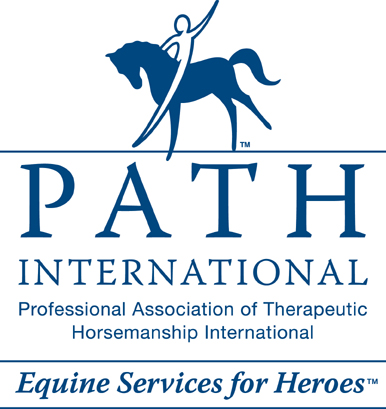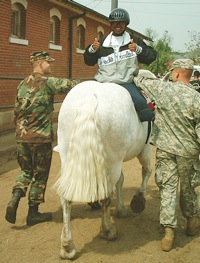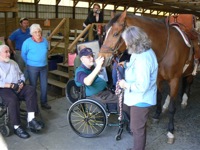Start a PATH Intl. Equine Services for Heroes Program
 The PATH International Equine Services for Heroes® mission is to assist military personnel and veterans through services available at PATH International Member Centers. Equine-assisted activity and therapy programs are tailored to address specific issues faced by wounded and traumatized military personnel, while also providing a supportive and therapeutic environment for their families and loved ones. The PATH International Equine Services for Heroes Task Force, in conjunction with staff at PATH International’s national office, provides leadership and guidance for practicing EAAT with this special population.
The PATH International Equine Services for Heroes® mission is to assist military personnel and veterans through services available at PATH International Member Centers. Equine-assisted activity and therapy programs are tailored to address specific issues faced by wounded and traumatized military personnel, while also providing a supportive and therapeutic environment for their families and loved ones. The PATH International Equine Services for Heroes Task Force, in conjunction with staff at PATH International’s national office, provides leadership and guidance for practicing EAAT with this special population.
To accomplish this mission and reach ever more veterans in need, PATH International Centers are encouraged to connect with Department of Veterans Affairs Medical Centers and Clinics, as well as individual military personnel and veterans.
If you are interested in starting a PATH International Equine Services for Heroes at your center, please read over the guidelines below. There are many important factors to consider and special measures to take before implementing PATH International Equine Services for Heroes, and it’s important that your center and community are ready for such undertakings. If, after reviewing this information, you have any further questions on starting a PATH International Equine Services for Heroes, please contact Danielle Crooks or the PATH International office at (800) 369-7433, ext. 115.
Click here for the informational brochure on starting a program at your center.
PATH International Equine Services for Heroes Program Guidelines
- Program Development
 Determine if working with veterans and/or wounded service members can be added now or in the near future to your current program.
Determine if working with veterans and/or wounded service members can be added now or in the near future to your current program.- Determine a discipline or program area your center is capable of offering, and which might be the most useful:
- Ground lessons (grooming, tacking, horse care, etc.)
- Classroom activities
- Sports riding - setting goals for developing riding skills (may include competitions)
- Recreational/leisure riding skills
- Equine Facilitated Mental Health
- Hippotherapy
- Driving
- Vaulting
- Determine the funding requirements needed to expand your current program.
- Determine if the additional funding is available from existing resources or if it can be obtained through new scholarships or grants. This could include funding from Veterans’ Administration (VA) facilities, referring agencies, Disabled American Veterans (DAV), American Legion, etc. PATH International offers members the use of the Foundation Directory Online, a database of grantmakers found in the Members Only section of the website.
- Are licensed, credentialed health professionals on staff that can provide services? As per the PATH International Standards for Certification and Accreditation, Glossary of Terms section, a Licensed/Credentialed Health Professional is defined as, “physical therapists, occupational therapists, speech-language pathologists, psychiatrists, psychologists, physicians, nurses and rehabilitation specialists. Health professionals providing direct service ‘therapy’ through equine activities should have additional specialized training in the use of the equine as a component of treatment in their respective areas of expertise.” If not, can the sending institution/agency provide a professional or someone equally qualified? A medical consultant who is knowledgeable about appropriate activities for medically fragile participants might be needed. Is a health professional available from the referring agency or organization?
- Is the center interested and in a good position to enter into a contractual agreement with a government agency or another organization?
- Riders
 Can the program serve adults with a variety of disabilities?
Can the program serve adults with a variety of disabilities?- The Department of Veterans Affairs services all veterans, which include WWII, Korea, Vietnam, Iraq, and Afghanistan. Is the program willing to work with an older group of veterans?
- In working with an older population, conditions and equipment that are not typically used by participants may be used by the veterans or active duty personnel, such as urine collection and colostomy bags or catheters, oxygen tanks, prosthetic limbs, etc.
- Is the center willing to have a program where the spouses, children or other family members are present and may even want to ride at the same time?
- Riders will need to undergo a stringent screening for contraindications and precautions. Frequently, poly-trauma veterans have skull defects and other wounds that might contraindicate therapeutic riding, at least initially.
- Programs need to be aware that young men and women that are wounded in war may have a strong sense of “risk taking” or take advantage of the “dignity of risk” available through riding. Because they have been severely injured in their most virile and physically active years, riding may need to be as challenging for them as is safely appropriate.
- Some newly injured individuals continue to undergo treatments that may only allow them the opportunity to ride one or two times. This must be recognized and accommodated, especially when working with poly-trauma victims.
 Volunteers
Volunteers
- Are volunteers available to handle the program expansion?
- Is the center willing to contact local veterans groups such as the American Legion, Veterans of Foreign Wars (VFW), Disabled American Veterans (DAV), Reserve and National Guard units to identify volunteers who can help with transportation, and assist as side walkers for the veterans’ groups? All volunteers will need to be trained in accordance with the center policy. It has been proven that military personnel helping others in the military can be an enormous additional benefit of this program. It is strongly recommended the military volunteers be trained as side walkers and/or horse leaders so they can help during the lesson.
- Wounded service members are adults and can be challenging for mounting/dismounting, and especially for emergency dismounts. Appropriately sized and trained volunteers need to be available to help during lessons with this population.
- Volunteers need to receive special briefings for working with recently wounded military personnel. The “wounded warriors” are adults and should be treated as such. Appropriate, specific praise is acceptable. Condescending, false praise is not acceptable.
- Instructors and Licensed/Credentialed Health Professionals
- Are there PATH International Certified Instructors available to work with veterans and wounded service members?
- Are the health professionals certified by PATH International? If not, is a PATH International Certified Instructor “directly supervising” each equine-assisted activity? This means the certified instructor needs to be at the activity site and is aware of and responsible for the program activity in the arena or on the premises.
- Are the instructors willing to advance the riders’ skills to their fullest potential? Some of the recently wounded servicemen and women already have significant horse activity backgrounds. They need to be allowed to “be in charge” and ride to their full potential.
- Instructors should have a method for rider goal setting and tracking outcomes. The method must be acceptable to, and agreed upon, by the rider, and the goals must be acceptable to the rider, instructor and health care professionals involved.
- Equipment, Facilities and Horses
- Does the program have all items in the areas listed above to work with adults with a variety of disabilities?
- Are the equines to be used trained to accept and comfortable with wheelchairs, scooters, canes, walkers, metal prosthetics and related equipment?
- What type of activities besides riding can the center provide? This may include driving or other therapeutic sports and activities. If driving is available, is there an easy-entry or wheelchair-accessible vehicle?
- Based on the number of horses, equipment and facilities, what is the total number of veterans and wounded servicemen and women that can be served by the center? This would include number and size of group lessons or the number of private lessons.
View the PDF of the PATH International Equine Services for Heroes Program Guidelines.
Thank you for your interest in supporting the PATH International Equine Services for Heroes program. We appreciate your desire to help our Military Personnel and Veterans.